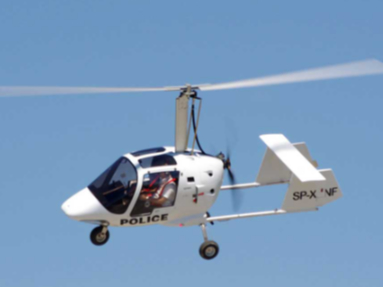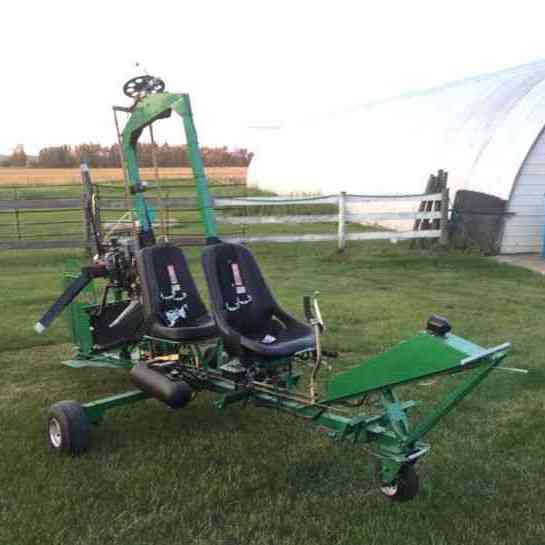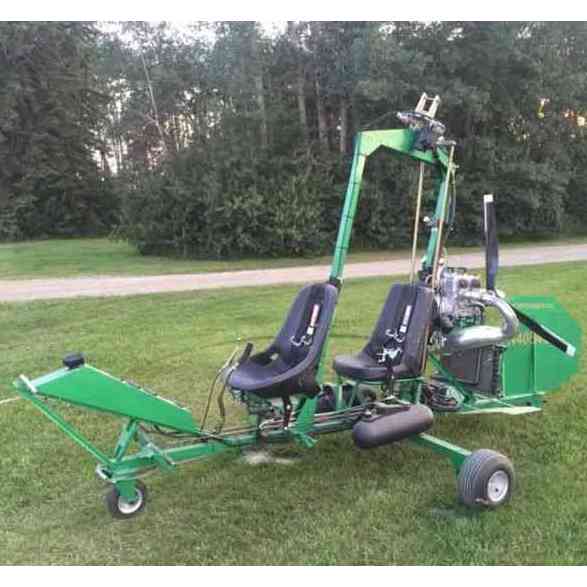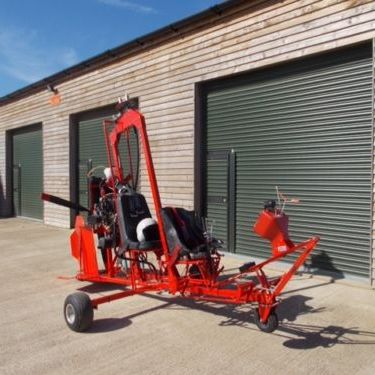Gyroplane pioneer Bill Parsons developed his first tandem-seat trainer in 1985 from a Bensen B-8M Gyrocopter in response to numerous accidents in learning to fly single-seat gyrocopters. His original trainer NWP54 is the one on display and was used to train over 600 pilots. Learning to fly a gyroplane is quite demanding. Previous to this aircraft, learning to fly on a dual control aircraft.
- Sport Copter is a second generation family business and building the worlds finest gyroplanes has been the sole function of the company. They have proven over the years to be the leader in design concept and continue to improve quality, enhance performance and increase safety standards within the rotorcraft industry., Nate (Composite Specialist), Jon Dailey (Master Rota), Composite honeycomb.
- Sport Copter is a second generation family business and building the worlds finest gyroplanes has been the sole function of the company. They have proven over the years to be the leader in design concept and continue to improve quality, enhance performance and increase safety standards within the rotorcraft industry., Nate (Composite Specialist), Jon Dailey (Master Rota), Composite honeycomb.
- Sport Copter is a second generation family business and building the worlds finest gyroplanes has been the sole function of the company. They have proven over the years to be the leader in design concept and continue to improve quality, enhance performance and increase safety standards within the.
- Two-seater gyrocopter SC-200 2-stroke engine open canopy Experience the Best Flight Experience the best flight civil aviation offers. Our gyro has easy handling, extreme flight safety, high comfort levels, low aquisition and maintenance costs and multipurpose design.
Bensen B-8 Gyro-Glider
In 1954, Igor Bensen designed the Gyroglider as a means to introduce aviation enthusiasts to the thrills of flight with minimal cost. The pilot relied on an automobile to pull the aircraft aloft. The movement of air through the rotor disc caused the blades to autorotate, which provided lift.
Available in the form of a complete kit or as a set of drawings, the Bensen B-8 Gyro-Glider was the first gyrocopter of simple design and construction that can be built by homebuilders.
Basically, the machine is as lightweight tubular aluminum structure with fin and rudder in plywood. The rotor blade is made of laminated plywood and is titled by a stick to control direction of flight.

QUICK VIEW:Bensen B8 Technical Characteristics (PDF)
Hundreds of kits and drawings have been sold (and continue to be sold) and some were even used by the USAF as the X-25B for military assessment.
A powered version, called B-8M Gyro-Copter, flew in July 1957. The engine installed on the mast behind the pilot was a flat four McCulloch 4318 or a 1600cc Volkswagen engine creating a small, robust, cross-country flyer.
The Bensen B8 gyro-glider was also later modified to become a two seat trainer as seen here.
Some machines were fitted with floats and known as the Hydro-Copter.
Bensen B-8 Gyro-Glider characteristics:
Length: 3.45m
Rotor diameter: 6.10m
Height: 1.9m
Empty weight: 58kg
DO NOT USE GMAIL, HOTMAIL OR YAHOO ACCOUNTS TO ORDER THESE PLANS!
1. Gmail, Hotmail and Yahoo blocks our server, why? we do not know.
2. Gmail, Hotmail and Yahoo limits the size of the download, so we cannot send it manually!
3. Gmail, Hotmail and Yahoo blocks our email address or places it in your spam folder – so we have NO WAY of communicating with you or responding to your emails.
| WA-116 Agile | |
|---|---|
| Little Nellie, pictured with its creator Ken Wallis in the cockpit. | |
| Role | Single-seat autogyro |
| National origin | United Kingdom |
| Manufacturer | Wallis Autogyros Limited |
| Designer | Ken Wallis |
| First flight | 2 August 1961 |
| Number built | 10+ |
The Wallis WA-116 Agile is a British autogyro developed in the early 1960s by former Royal Air Force Wing Commander Ken Wallis. The aircraft was produced in a number of variants, one of which, nicknamed Little Nellie, was flown in the 1967 James Bond film You Only Live Twice.
2 Seat Gyrocopter Plans Comparison
Design and development[edit]
Wing Commander Ken Wallis, a former RAF pilot, developed a number of improvements to the autogyro design, including the offset gimbal rotor head which gives the autogyro hands-off stability.[1] Wallis' first prototype autogyro, registeredG-ARRT, was first flown on 2 August 1961.[2]
Operational history[edit]
In 1962, five WA-116s were built by Beagle Aircraft at Shoreham, three of which were for evaluation by the British Army Air Corps. Wallis flew one of these aircraft, XR942, at that year's Farnborough Air Show.[2]
In 1966, one of the Beagle-built WA-116s, registered G-ARZB, was modified for use in the James Bond film You Only Live Twice.[3] Little Nellie was named after legendary music hall performer Nellie Wallace.[4]
Few Wallis autogyros have been operated privately, with nearly all of them being used for research and demonstration flying by Wallis himself.[3] Wallis withdrew all his autogyros from use by anyone other than himself, after the crash of WA-117 G-AXAR at the 1970 Farnborough Air Show.[5]
Operators[edit]
- United Kingdom
4 Passenger Gyrocopter

Variants[edit]
- WA-116 Agile
- Prototype autogyro powered by a Wallis-McCulloch 4318A engine.[2][6]
- WA-116-T
- Two-seat variant, one built.[2]
- WA-117 Venom
- Variant powered by a 100 hp (75 kW) Rolls-Royce Continental O-200-B engine.[2]
- WA-118 Meteorite
- Variant powered by a 120 hp (89 kW) Wallis-modified Meteor Alfa supercharged two-stroke engine.[7]
- WA-119
- Variant powered by a 40 hp water-cooled 990 cc Hillman Imp engine.[2]
- WA-121
- Streamlined variant for high-altitude research with a Wallis-McCulloch 4318A engine; a single WA-121 was built in 1972.[2]

Specifications (WA-116)[edit]
Data from British Civil Aircraft since 1919 – Volume 3[2], Flight 31 March 1966 : The Wallis Autogyros[8]
General characteristics
- Crew: 1
- Length: 11 ft (3.4 m)
- Empty weight: 255 lb (116 kg)
- Gross weight: 550 lb (249 kg)
- Fuel capacity: 58 lb (26.3 kg)
- Powerplant: 1 × Wallis-McCulloch 4318A 4-cylinder air-cooled horizontally-opposed piston engine, 72 hp (54 kW)
- Main rotor diameter: 20 ft 4 in (6.20 m)
- Main rotor area: 324.8 sq ft (30.17 m2)
- Propellers: 2-bladed fixed-pitch pusher propeller
Performance

- Maximum speed: 87 kn (100 mph, 161 km/h)
- Range: 209 nmi (241 mi, 387 km)
- Endurance: 2 hours 27 minutes
- Service ceiling: 10,000 ft (3,000 m)
- Time to altitude: 1,000 ft (305 m) in 56 seconds
- Power/mass: 0.1307 hp/lb (0.2149 kW/kg)
See also[edit]

References[edit]
Notes[edit]
- ^'The Wallis Autogyros.'Flight. 31 March 1966. p. 515.
- ^ abcdefghJackson (1974). p. 329.
- ^ abApostolo (1984). p. 101.
- ^ Places & Faces, 'The Name's Wallis' (accessed 2013-12-12)
- ^'ASN Wikibase Occurrence # 19511'. Aviation Safety Network. Retrieved 18 July 2020.
- ^Note, the McCulloch 4318A is a four-cylinder, horizontally-opposed two-stroke engine originally intended for limited-life drone applications.
- ^https://www.flightglobal.com/FlightPDFArchive/1966/1966%20-%201560.PDF
- ^'THE WALLIS AUTOGYROS'. Flight International. Volume 89 (Number 2977): p.p.515-520. 31 March 1966.
Bibliography[edit]
- Apostolo, Giorgio (1984). The Illustrated Encyclopedia of Helicopters. New York: Bonanza Books. ISBN0-517-439352.
- Jackson, Aubrey J. (1988). British civil aircraft, 1919-1972 Volume III (2nd., repr. with corrections ed.). London: Putnam. p. 329. ISBN0851778186.
Hornet Gyrocopter Plans
